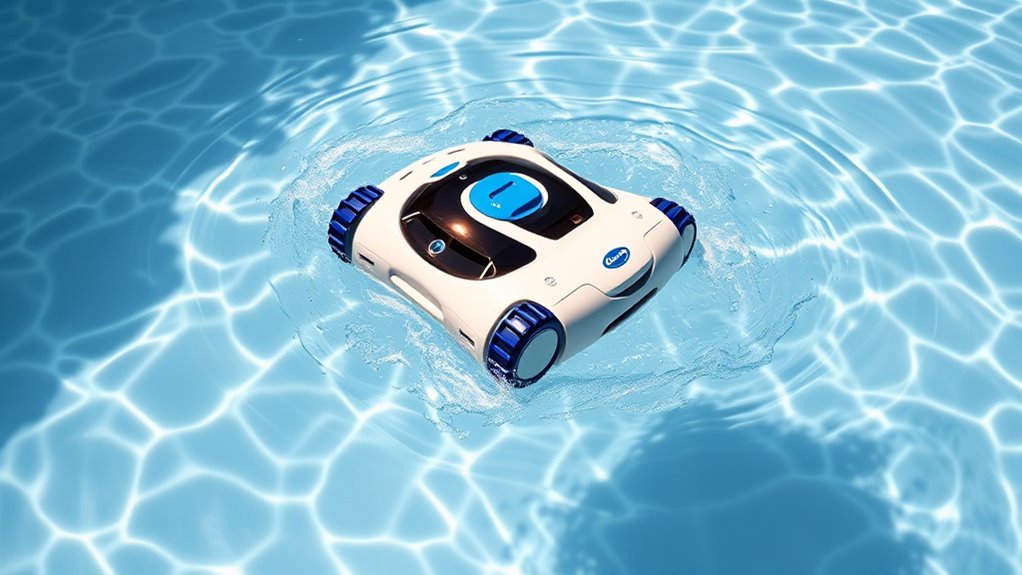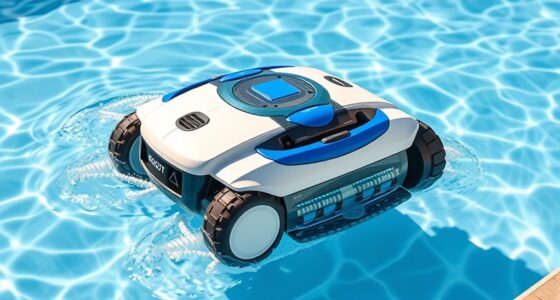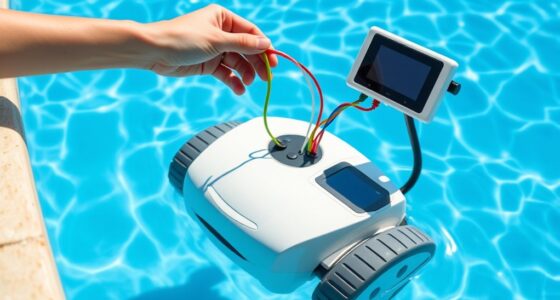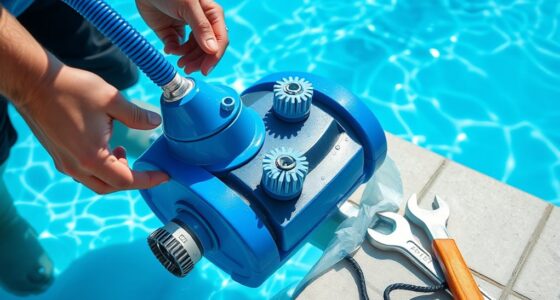Pressure pool cleaners use a booster pump and high-pressure jets to quickly cover large areas, making them ideal for big pools, but they can be loud and cost more in the long run. Robotic cleaners operate independently, scrubbing surfaces thoroughly with smart navigation, and are easier to use overall. Depending on your pool size and features, choosing the right fit can improve your cleaning routine. Keep going to discover which option suits your needs best.
Key Takeaways
- Pressure cleaners use a booster pump and high-pressure water jets, while robotic cleaners operate independently with internal motors.
- Robotic cleaners scrub surfaces thoroughly and navigate complex pool features better than pressure cleaners.
- Pressure cleaners are generally cheaper upfront but may incur higher energy costs compared to robotic models.
- Robotic cleaners are easier to operate, require less manual setup, and offer programmable cleaning schedules.
- Pressure cleaners are suitable for large, open pools; robotic cleaners excel in pools with steps, corners, and intricate features.
How They Work
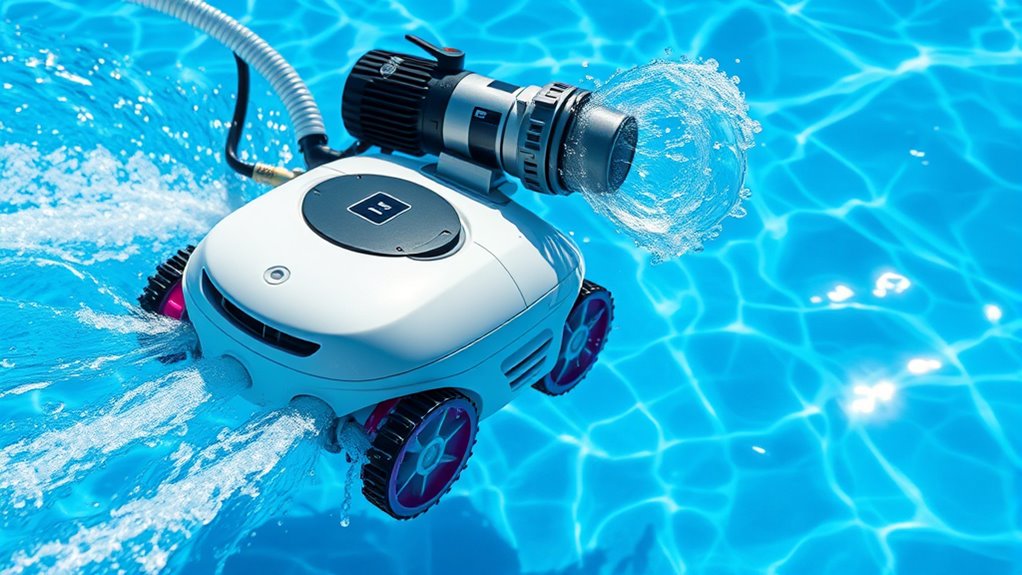
Pressure pool cleaners work by using a dedicated booster pump that generates high-pressure water jets. These jets propel the cleaner around your pool, making them effective for larger pool sizes, as they can cover extensive areas quickly. The booster pump is connected to your pool’s filtration system, boosting water flow and creating the necessary pressure. However, this increased power consumption can lead to higher energy bills, especially if you have a sizeable pool. The cleaner’s movement relies on the force of the water jets, which pushes it along the pool floor and walls. Because of their dependence on a powerful pump, larger pools tend to require more energy, making them less efficient for small pools but great for tackling big spaces quickly. Additionally, pressure cleaners typically require more maintenance due to the higher strain on their components, which can impact their longevity and performance over time. Energy consumption is an important factor to consider when choosing a pool cleaner, particularly for larger pools, and understanding cleaner efficiency can help in making an informed decision. Proper regular maintenance can extend the lifespan of these cleaners and ensure optimal performance over time, especially since their complex parts may be more prone to wear and tear. Moreover, proper maintenance can extend the lifespan of these cleaners and ensure optimal performance over time.
Effectiveness in Cleaning
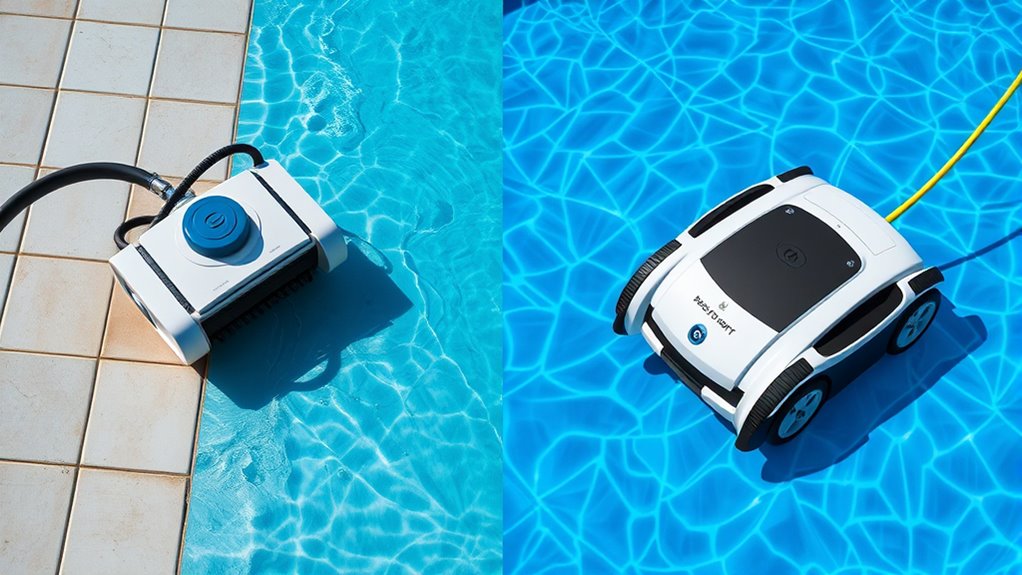
Robotic pool cleaners excel in their ability to thoroughly scrub your pool’s surfaces without relying on high-pressure water jets. They are highly effective at removing dirt, algae, and debris, ensuring a clean pool with minimal effort. To maximize their effectiveness, consider these points:
- Energy consumption: Robotic cleaners typically use less energy than pressure cleaners, making them more eco-friendly and cost-efficient over time. Energy efficiency is a key benefit of robotic models compared to traditional pressure systems.
- Cleaning coverage: They navigate your pool systematically, reaching corners and steps that pressure cleaners might miss. Navigation systems further improve their ability to cover the entire pool surface efficiently.
- Noise levels: Robotic models operate quietly, allowing you to enjoy a clean pool without disruptive noise.
- Smart features such as programmable schedules and remote control capabilities further enhance their cleaning efficiency and user convenience. Additionally, some models incorporate advanced sensors that help detect and adapt to different pool surfaces for optimal cleaning.
Cost and Maintenance
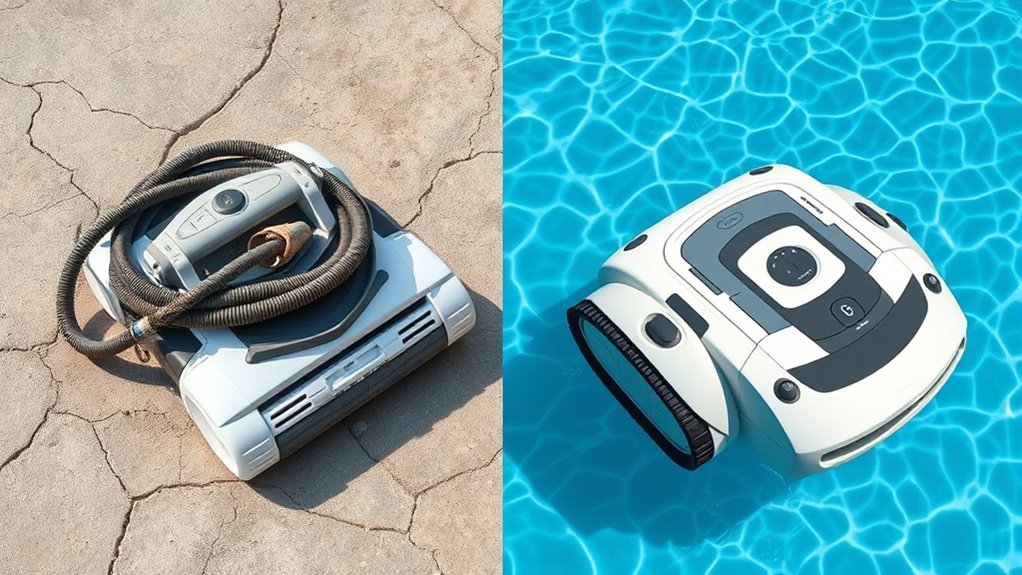
Robotic pool cleaners tend to have higher upfront costs but can save you money in the long run through lower energy consumption and fewer chemicals needed for maintenance. Many models come with extensive warranty coverage, which helps protect your investment and reduces repair costs. Since robotic cleaners operate independently of your pool’s filtration system, they use less energy, leading to lower utility bills. Maintenance is generally straightforward; you’ll need to clean filters and occasionally inspect parts, but overall, robotic cleaners are designed for durability. Their warranties often cover key components, giving you peace of mind. Additionally, their predictable performance can contribute to more consistent pool cleanliness and reduce the need for manual cleaning. Modern tuning options in pool cleaners can further optimize their efficiency and lifespan, ensuring you get the most value over time. Incorporating vegetable-based cleaning techniques can even enhance the sustainability of your pool maintenance routine, aligning with eco-conscious practices. Investing in a robotic cleaner with energy-efficient features can also help reduce your overall environmental footprint, especially when combined with regular preventive maintenance to keep the device functioning optimally.
Ease of Use and Convenience
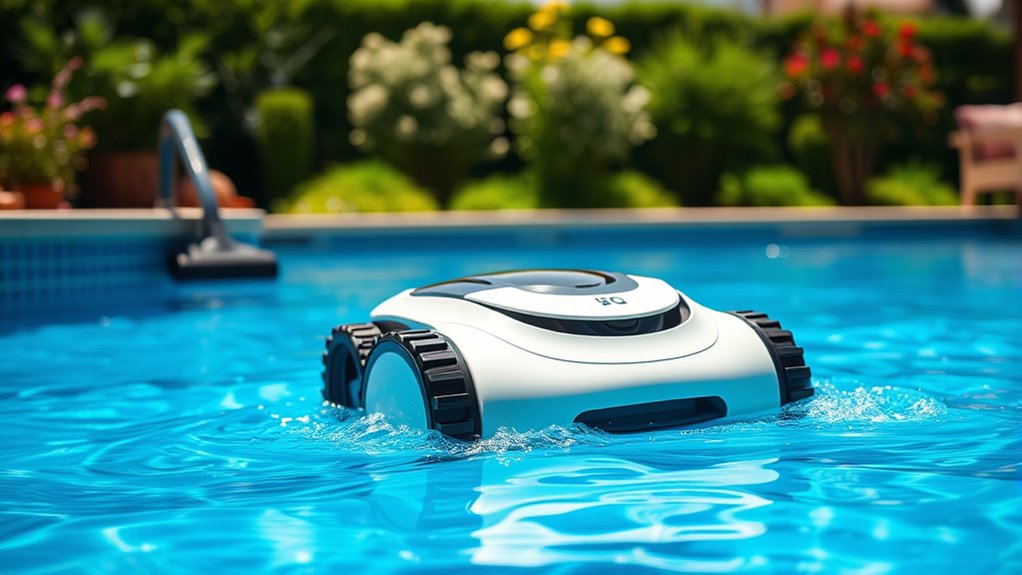
Because they are designed for user-friendly operation, robotic pool cleaners offer exceptional convenience. You’ll find that their intuitive user interface makes setup and control straightforward. Unlike pressure cleaners, which often require manual operation and constant supervision, robotic models typically feature simple controls and automated functions. To enjoy the ease of use, consider these points:
Robotic pool cleaners offer effortless operation with intuitive controls and automated cleaning cycles for maximum convenience.
- Automated cleaning cycles that require minimal input.
- Clear, easy-to-navigate user interfaces for quick adjustments.
- Less manual operation needed, freeing you from constant supervision.
- Their emotional support features can help reduce stress associated with pool maintenance. Additionally, their user-friendly design reduces the learning curve, making it accessible for users of all experience levels. Moreover, the integration of advanced technology enhances their ability to adapt to different pool shapes and sizes, further simplifying maintenance. This intuitive operation is supported by their smart sensors that optimize cleaning paths and coverage. By incorporating smart sensors, robotic cleaners can better detect obstacles and adapt their movements accordingly, providing more efficient cleaning. This means you spend less time managing the cleaner and more time enjoying your pool. Robotic cleaners are built for convenience, making maintenance less of a hassle and more of a pleasure.
Suitability for Different Pool Types

Choosing the right pool cleaner depends heavily on your pool’s type and setup. For large pools, pressure cleaners often cover extensive areas quickly, making them suitable for bigger spaces. However, if your pool has complex features like steps or corners, robotic cleaners tend to be more effective due to their precise navigation and ability to adapt to various surfaces. Consider your pool size when selecting a cleaner, as smaller pools may not justify the investment in a robotic model. Installation complexity also matters; pressure cleaners typically require straightforward setup with existing hoses, while robotic cleaners often need an electrical outlet and may involve more initial setup. Assess your pool’s specific features and your comfort with installation to choose the most suitable cleaner. Additionally, understanding Ford Tuning options can help optimize your pool equipment’s performance for better efficiency and longevity. Moreover, evaluating the types of debris your pool typically accumulates can guide you toward a cleaner with the right filtration and suction power. Ensuring your pool’s filtration system is compatible with your chosen cleaner can enhance overall efficiency and prolong equipment life. Proper maintenance and selecting the right tuning can also extend the lifespan of your pool equipment, ensuring consistent performance. Additionally, considering regular cleaning schedules can help maintain optimal pool conditions and prevent debris buildup over time.
Frequently Asked Questions
Which Type Lasts Longer, Pressure or Robotic Pool Cleaners?
When considering which pool cleaner lasts longer, you want to look at durability comparison and longevity factors. You might find that robotic cleaners often have a longer lifespan because they’re built with advanced components and are designed for continuous use. Pressure cleaners, while effective, tend to experience more wear and tear over time. Your choice depends on maintenance, usage frequency, and build quality, but robotic models generally offer better longevity.
Are Robotic Cleaners More Environmentally Friendly Than Pressure Models?
Imagine giving your pool a gentle, eco-conscious touch. Robotic cleaners often offer eco-friendly benefits, thanks to their energy efficiency and targeted cleaning. You’ll appreciate how they use less power, reducing your carbon footprint while keeping your pool pristine. With fewer emissions and less water waste, robotic models align better with sustainable living. So, if you’re aiming for greener choices, robotic cleaners are a smart and environmentally friendly option for your pool maintenance.
Can Pressure or Robotic Cleaners Handle Large Debris Effectively?
When it comes to handling large debris, your choice depends on debris capacity and cleaning speed. Robotic cleaners typically have smaller debris bins but clean efficiently with steady speed, while pressure models often have larger debris capacity, allowing them to handle big debris more effectively. If you need quick, thorough cleanup of large debris, pressure cleaners usually perform better, but robotic cleaners excel in detailed, consistent cleaning.
Do Pressure or Robotic Cleaners Require Professional Installation?
You don’t need a professional for DIY setup of pressure or robotic pool cleaners. They’re designed for easy installation, often with straightforward instructions. However, consider cost considerations—pressure cleaners tend to be cheaper and simpler to set up, while robotic models might require a bit more effort and investment. Overall, with basic tools and patience, you can install either type yourself, saving money and time.
How Do Maintenance Needs Compare Between Pressure and Robotic Cleaners?
When comparing maintenance needs, you’ll find robotic cleaners generally require less effort and upkeep, making them more energy-efficient over time. They need regular brushings and filter changes but tend to be easier to maintain. Pressure cleaners might require more frequent adjustments and parts replacement. Regarding cost comparison, robotic cleaners often have higher initial costs but save you money on maintenance and energy, providing a more efficient option overall.
Conclusion
Choosing between pressure and robotic pool cleaners depends on your needs, budget, and pool type. Both options can transform your pool cleaning routine from a tedious chore to a breeze, but only one can truly claim to be the superhero of pool maintenance. Consider how each fits into your lifestyle, and you’ll find the perfect match. With the right cleaner, you’ll enjoy crystal-clear water and endless summer fun—no more drudgery, just effortless sparkle!
